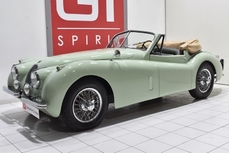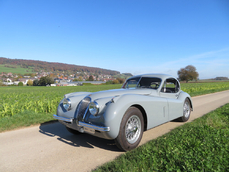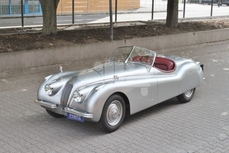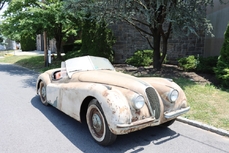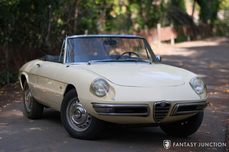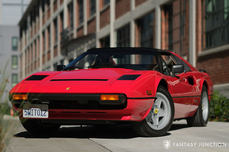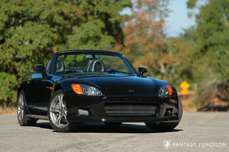Jaguar XK120 3.8 Liter Inline-6 no. LA2767-8 1950
Allgemeine Beschreibung :
1950 Jaguar XK 120 Alloy Roadster
Chassis No. 670110, engine no. LA 2767-8
Brushed Aluminum with Blue Leather Interior
In 1948, Jaguar revealed the XK 120 to the British public as a potential concept car to showcase the firms’ capability with leading edge technology and the latest in aerodynamic design. For the demure Brits, emerging from post-war economic austerity, the XK120 caused quite a stir. The newly conceived XK 120 was nothing short of a revelation. This truly avant-garde car quickly demonstrated to the world that Britain had the technical capacity and fortitude to deliver a beautiful and innovative world-class sports car. Although originally intended to be a concept car to showcase Jaguar’s remarkable new twin-cam inline-6 cylinder engine, the breathtaking styling and genuine 120 mph performance, coupled with an affordable price, captured the imagination of the world. In short order, the largely hand-built aluminum-bodied car was rushed into limited production as orders came flooding in. With time and delivery pressures growing, Jaguar reengineered the car for mass production with steel bodies, developing stamping tools capable of producing thousands of cars. A mere 242 aluminum examples were built before the XK120 shifted to steel production, making the lighter and largely handcrafted aluminum cars forever rare and desirable.
This XK120 is a particularly unique alloy example, originally designated for delivery to James Cooke of Toronto Canada. One of just 184 LHD cars built, the car was completed on February 17, 1950, finished in Pastel Blue with Duo-Blue interior, and shipped to Canada. Although little is known about the car during the time it resided in Canada, the next documented owner is known to have been Mr. John D. DeHaan, who purchased the car from Fred Lake, of Brea, California in 1981. At that time, Mr. Lake had two early alloy XK120s for sale, 670110 and 670120, and DeHaan selected 670110 as a rolling chassis, complete with the disassembled alloy body, but no engine. At the time of purchase, the car was titled in California using the engine number W10438. Mr. DeHaan intended to restore the car but never ended up doing so and sold the car to noted Jaguar expert Jim Groom of Groom’s Sportscar Services, Berkeley, CA. Shortly after that, the car was purchased by the current owner, who commissioned a restoration, configuring the car specifically for vintage racing. He elected to honor the beautifully constructed alloy body by finishing it in brushed aluminum, with the hood draped in colorful livery depicting the Union Jack. In 2010, Jim Groom was enlisted again to rebuild the engine currently in the car. From 2009 - 2017, the car competed in numerous races on the West Coast, competing in one or two vintage racing events each year, passing technical inspections as noted in the accompanying CSRG Vehicle Log Book #09-001.
Today the car presents as a tribute to the purity and sculptural quality these early XK120s are so admired for. The purposeful raw aluminum body is evocative and handsome, wearing evidence of use with pride. Minor scratches, dents, and occasional surface imperfections add to this car’s authenticity and no-nonsense presentation. Overall, the body is in very good condition showing nice contours and panel fit, none of which can be fudged via preparation, filler, or paint. What you see on the surface is actually the body. The comprehensive restoration work performed on the car included removing the windscreen, adding ducted fully covered rear fender spats, a roll bar, and removing the bumpers. In place of the windscreen, a matching formed aluminum cowl fairing and rear view mirror shroud complete the impressive, handcrafted period racing look. Components throughout the car were thoughtfully and comprehensively addressed with vintage appearing presentation in mind. The hood, door (the passenger’s door is fixed), and trunk shut and latch properly. The exterior look is completed with understated painted steel wheels, an original Jaguar nose badge, chrome-trimmed headlights, and grille. Overall the exterior visual presentation is one of a delightfully conceived racecar that immediately charms anyone who appreciates the bombastic fury and delight of a purposeful machine crafted with pride.
The nicely restored interior, now shows a light patina, which has settled very evenly into the materials and adds to the cockpit like feel of the car. The leather seats are properly bolstered and comfortable with a nice hue and sheen, while the matching trimmed door panels follow the body contours against the raw aluminum structure. The roll bar, colorfully boasting the many races in which this car has competed features a padded headrest and properly anchored racing seatbelts. The car’s owner is on the tall side and the car is currently configured to accommodate a tall driver, with smaller (but correct appearing steering wheel) and fixed driver’s seat mounted as close to the floor as possible. A few race required switches on the otherwise largely original dash, a nice set of original instruments, an original black steering wheel, and thoughtfully engineered metal foot pedals further complete the purposeful cockpit, all of which is consistently finished and in very presentable condition. None of the interior components are out of visual character with the exterior appearance of the car, in fact, the look is cohesive and uniformly finished even when opening the doors to reveal the painted metal floor and aluminum formed door skins, here again, finished in raw aluminum. The underside of the trunk features primed red-oxide lightened steel substructure much like aircraft fuselage design, here too very much in keeping with the interior look with the trunk compartment painted metal contrasting against the raw aluminum fuel tank, here too celebrating the elegant and purposeful engineering of a race-bred sports car.
Under the hood, the beautiful 3.8 liter dual-overhead camshaft engine, sourced from a later car, is perfectly at home. The casting finishes have just the right amount of sheen in combination with a blend of correct components and select handmade components in keeping with the vintage nature of the car. The restoration work has settled here as well but the finishes are consistent throughout. The overall condition of the engine is very nice, displaying handsome luster and detailing beyond what is generally seen in a typical vintage racecar. The undercarriage still remains very nicely done revealing the attention to detail given when restored. The car appears to have been properly cleaned and currently shows only minor areas of aging since the restoration was completed. In all, the underside components are very presentable, consistent with the themes of the car, demonstrating proper care and use.
The car starts easily erupting in a fury of sound that captivates innocent bystanders even at a distance. The engine sounds are raw and eager, much like the livery, once again cohesively creating a total experience even when sitting at idle. The gearbox is easily engaged and once underway, within moments you are fully enveloped in a furious combination of wind and noise, much like a fighter pilot might have felt readying for take off. Acceleration is brisk in all gears with tremendous pull and great power as revs climb and you experience that combination of vibration and roar as speeds increase. Handling is a delight when at speed, particularly enhanced by the open coachwork and low profile windscreen.
This is an outstanding opportunity to acquire a car that captures the XK120 spirit, in a wonderfully competent and sorted vintage race car. A genuine alloy bodied XK120, this car is exceptionally rare and represents strong value for such a significant car. It has been built by one of the best in the business and is a well-sorted turnkey car that is competitive on the track in addition to being California titled and street legal. This Jaguar offers the next fortunate racing enthusiast a rare opportunity to own and drive a very special and uniquely prepared car, ready for vintage events while still capable of delighting crowds of appreciative onlookers at any show.
http://fantasyjunction.com/cars/2112-Jaguar-XK120%20Alloy-3.8%20Liter%20Inline-6
1950 Jaguar XK120 3.8 Liter Inline-6 no. LA2767-8 is listed verkauft on ClassicDigest in Emeryville by Fantasy Junction for $160000.
Fakten der Auto
Karosserietyp : Auto Marke : Jaguar Modell : XK120 Ausführung : 3.8 Liter Inline-6 no. LA2767-8 Hubraum : 3.8 Modelljahr : 1950 Lage : Emeryville
Verkauft
Angaben Zum Verkäufer
Verkauft
People who viewed this Jaguar XK120 also viewed similar Jaguar listed at ClassicDigest
Other cars listed for sale by this dealer
über Jaguar
Ah, die Geschichte von Jaguar, von seinen Anfängen als SS Cars Ltd. bis hin zum Höhepunkt mit dem D-Typ und der Straßenversion des ikonischen E-Typs. An dieser Erzählung haftet etwas zutiefst Britisches, und ich werde sie erzählen, wie es ein britischer Journalist tun würde.Die Anfänge:
Unsere Reise in die Welt von Jaguar beginnt in den 1930er Jahren, als ein Unternehmen namens SS Cars Ltd. auftauchte. Trotz des unglücklichen Zufalls ihrer Initialen, die mit den aufkommenden politischen Spannungen in Europa zusammenfielen, begannen sie, stilvolle und leistungsorientierte Autos herzustellen. Der SS 100, der 1936 eingeführt wurde, war ein Symbol für Eleganz und Geschwindigkeit und legte den Grundstein für das, was Jaguar werden sollte.
Die Geburt von Jaguar:
Als der Schatten des Zweiten Weltkriegs näher rückte, entschied sich SS Cars Ltd. klugerweise, sich von den SS-Initialen zu distanzieren. So wurden sie 1945 offiziell zu Jaguar Cars Ltd., ein Name, der bald für britischen Luxus und Leistung stehen würde.
Die XK-Serie:
Die Nachkriegszeit von Jaguar brachte uns den XK 120, eine wahre Sensation im Jahr 1948. Mit seinem schlanken Design und einem leistungsstarken 3,4-Liter-Sechszylindermotor wurde er zum schnellsten Serienauto der Welt. Der XK 120 war die Blaupause für das, was kommen würde - Jaguars, die Stil mit Geschwindigkeit auf einzigartig britische Weise verbanden.
Die Dominanz des D-Typs:
Dann kam der D-Typ, eine wahre Rennlegende. 1954 eingeführt, gewann er in den 1950er Jahren dreimal Le Mans und zeigte die technische Kompetenz von Jaguar. Mit seiner innovativen Monocoque-Konstruktion und der ikonischen Finne hinten war der D-Typ der Höhepunkt von Jaguars Motorsporterfolgen.
Das Auftauchen des E-Typs:
Aber der wahre Wendepunkt kam 1961 mit der Einführung des E-Typs, oft von Enzo Ferrari als "das schönste Auto, das je gebaut wurde" bezeichnet. Seine lange Motorhaube, die geschwungene Karosserie und ein 3,8-Liter-Motor, der atemberaubende Leistung lieferte, machten ihn sofort zu einem Klassiker. Der E-Typ war nicht nur ein Auto; er war ein Kunstwerk auf Rädern und konnte auf der Straße 150 Meilen pro Stunde erreichen.
Straßen- und Rennsporterfolge:
Die Schönheit des E-Typs wurde durch seine Leistung auf der Rennstrecke unterstrichen. Die leichten E-Typen waren bei verschiedenen Rennveranstaltungen besonders erfolgreich und festigten den Ruf von Jaguar als eine Kraft, mit der man im Motorsport rechnen musste.
Das Zeitalter der Raffinesse:
Je tiefer wir in die Geschichte von Jaguar eintauchen, desto mehr erkennen wir, dass die 1950er und 1960er Jahre ein Zeitalter der Raffinesse und Expansion waren. Neben dem großartigen D-Typ und dem ikonischen Aufstieg des E-Typs führte Jaguar Modelle ein, die seinen Ruf für Luxus und Leistung weiter festigten.
Der MK2:
Ende der 1950er Jahre stellte Jaguar den MK2 vor, eine Sportlimousine, die Eleganz mit Leistung vereinte. Diese elegante viertürige Limousine war sowohl bei Bankräubern als auch bei der Polizei aufgrund ihrer außergewöhnlichen Geschwindigkeit und Handhabung beliebt. Der MK2 war ein Symbol für Jaguars Fähigkeit, Raffinesse mit Leistung zu verbinden und hatte auch eine erfolgreiche Rennkarriere.
Der XJ6:
Springen wir ins Jahr 1968, als Jaguar ein Auto auf den Markt brachte, das Jahrzehnte lang Luxuslimousinen definieren würde - den XJ6. Es war ein Meisterwerk der Ingenieurkunst und des Designs, mit einem sanften Reihensechszylindermotor, unabhängiger Hinterachse und einem geräumigen, wunderschön ausgestatteten Innenraum. Der XJ6 war ein Symbol britischer Eleganz und bot eine so sanfte Fahrt, dass es schien, als würde er förmlich über die Straße gleiten. Er wurde zum Flaggschiffmodell für Jaguar und setzte den Maßstab für Luxuslimousinen und zeigte ein Maß an Raffinesse, das die Konkurrenz staunen ließ.
Die Verschmelzung von Klassik und Moderne:
Während der MK2 und der XJ6 die Evolution der Limousinen von Jaguar repräsentierten, bewahrten sie das Engagement der Marke für Leistung und Luxus. Diese Autos gehörten nicht nur auf die Rennstrecke; sie fühlten sich genauso wohl auf den Prachtstraßen wie auf einer entspannten Fahrt durch die englische Landschaft.
Die Herausforderungen des Wandels:
Dennoch sah sich Jaguar mit dem Eintritt der 1970er Jahre, wie viele britische Automobilhersteller, finanziellen Herausforderungen und Veränderungen in der Eigentümerschaft gegenüber. Die Ära von British Leyland brachte sowohl Chancen als auch Schwierigkeiten mit sich, während die Marke durch verschiedene Fusionen und Übergänge navigierte.
Das Erbe des MK2 und des XJ6, zusammen mit dem D-Typ und dem E-Typ, definiert Jaguar weiterhin als einen Hersteller, der zeitlose Eleganz mit einer Leistungsstärke vereint. Diese klassischen Modelle, ob sie über kurvige Straßen gefahren oder als Sammlerschätze geparkt werden, dienen als Zeugnis für die anhaltende Präsenz von Jaguar in der Welt der automobilen Exzellenz.
Die Jaguar-Geschichte, von ihren Anfängen als SS Cars Ltd. bis zur Schaffung von Automobilikonen wie dem E-Typ, dem MK2 und dem XJ6, ist eine Reise, die das Wesen des britischen Automobilbaus widerspiegelt - eine Mischung aus Luxus, Leistung und Stil, die nach wie vor Enthusiasten und Kenner gleichermaßen fasziniert.


